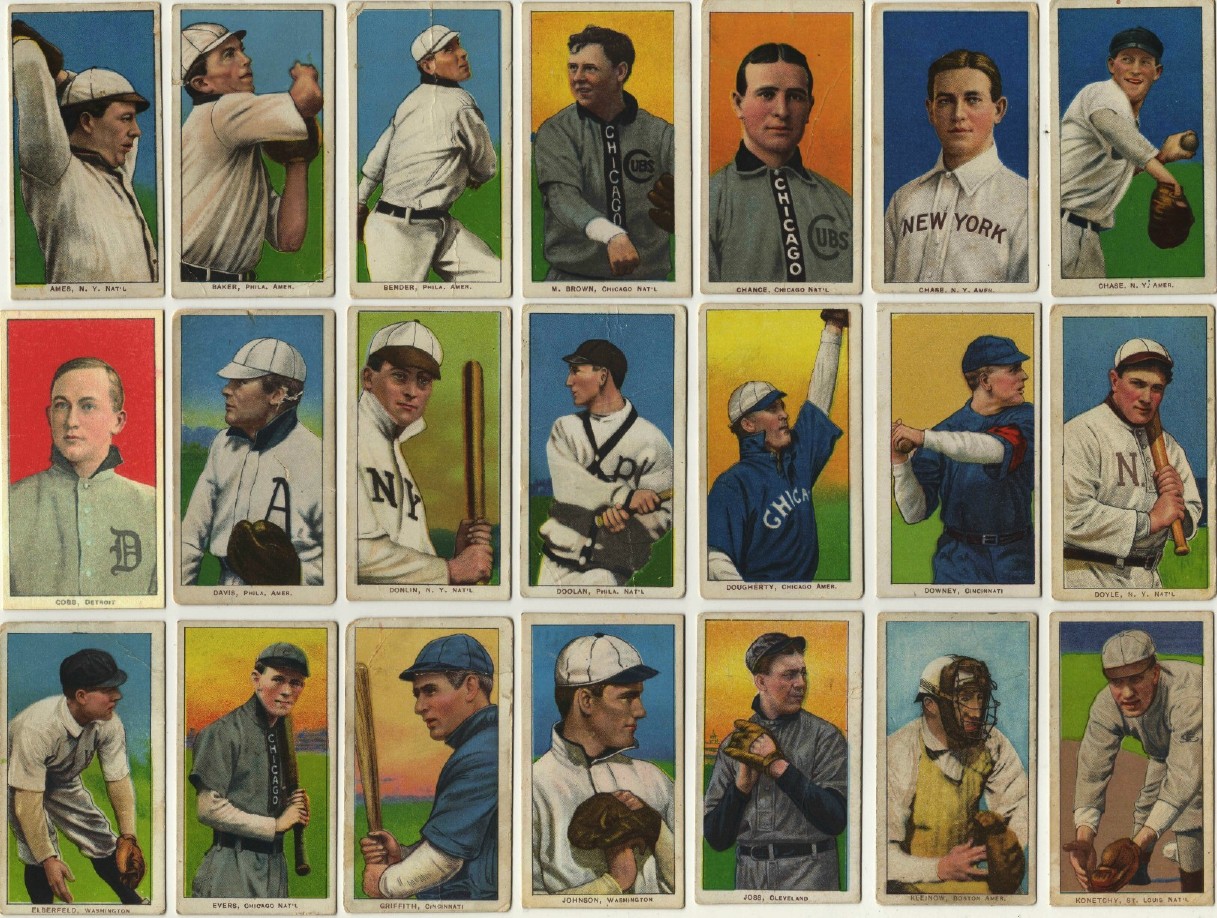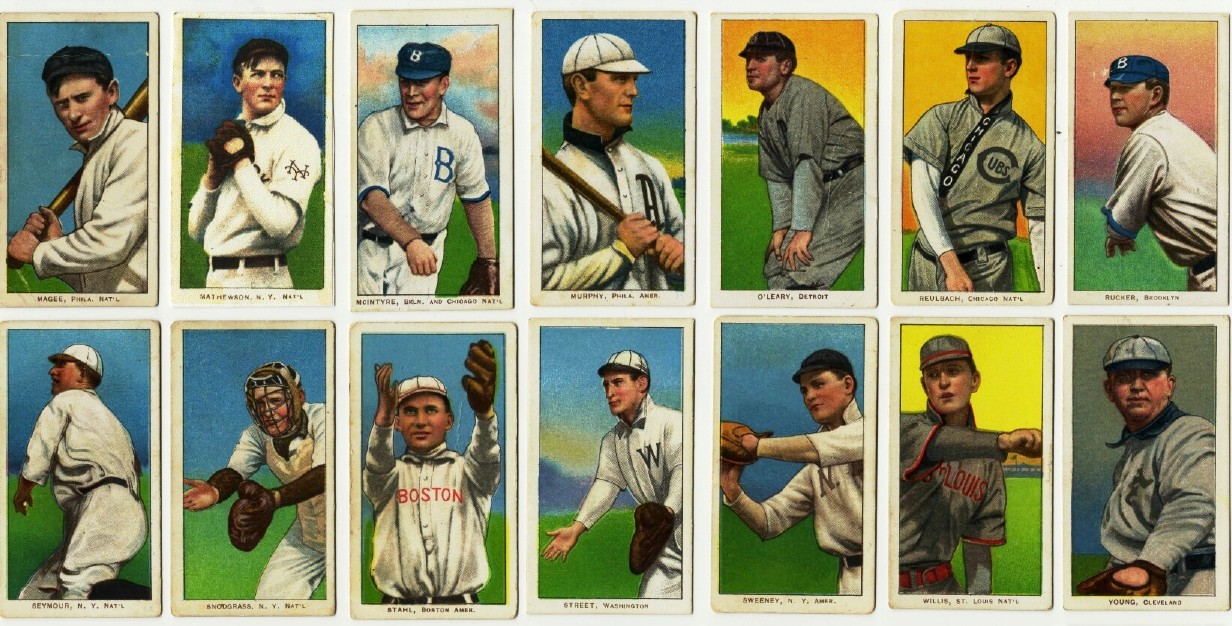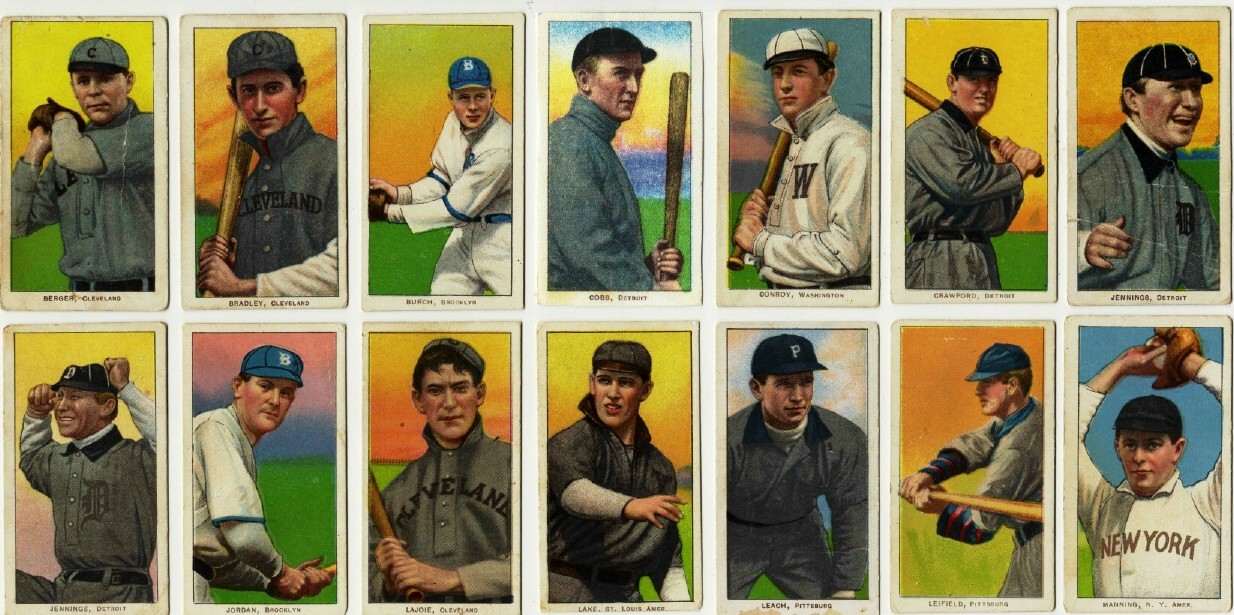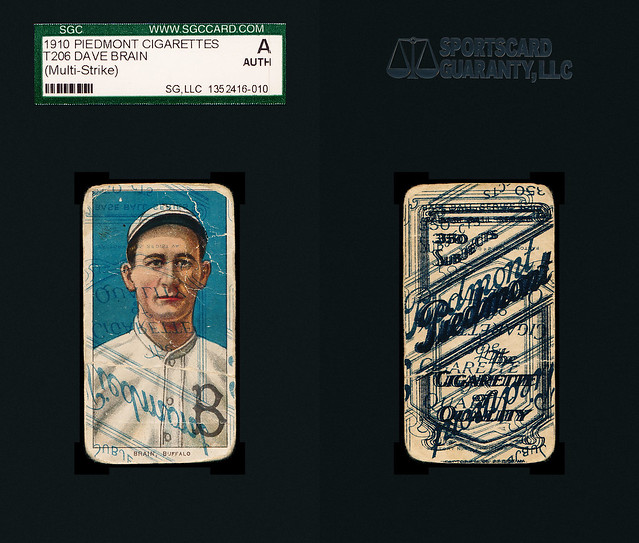|
|
#1
|
|||
|
|||
|
Well, I don't really expect much revision to happen, but maybe to get some ideas working, prompted by the thread about a Yellow/Brown T206.
They're the most common, so most will directly apply to 206s, but could be applied to every set. The use of the term Scrap for a yellow/brown got me thinking about how we use that term. As I said there it's a good catchall term for cards that aren't exactly normal and probably weren't pack issued because of that. Most break down into a couple different "paths" my term for how the item would have passed through production to either release, the scrap barrel, or internal use. The first "path" is cards that were complete or nearly complete and for some reason just didn't get finished. That can be anywhere from Simply not cut- perhaps because the sheet had problems far away from it, to cards that maybe just didn't get finished at all, but were intended to be finished. These would include, stuff like this Ewing, which is finished except for the cutting. Or blank backs, or maybe the factory 30 no prints without the overprint on the reverse. Most of that is probably just decent quality sheets that were leftover when the printer filled an order and moved on to whatever came next. The second "path" would be cards that were not really finished because of obvious problems like being very out of register (despite how lax the allowable registration seems to have been. ) sheets used to adjust the presses in some way. Most of the spectacular ones are cards from sheets used as make ready sheets for multiple jobs, or with the back reversed from normal. I would also put the Brown Old Mills and maybe the brown Lenox in this category. More the brown Old Mill, as I think the Brown Lenox are factory cut? Lenox in general is tough enough that the brown could be a group from a small order that was either first almost as smaples, or last just getting a few more to finish out the promotion. The third "path" is to me much more interesting. Cards that were not intended for release, or simply waste cardboard used to adjust the presses. American litho did sets of progressive proofs for a lot of what they printed for many tobacco companies. There are progressive proof books out there for a huge variety of cigar box labels. These books include a print from the master stone of each color, and various combinations of colors up to all colors. I think there may be a couple around for one of the non- sports sets but I don't recall for sure. I've never seen one for Baseball cards. It's possible the existing proofs came from booklets of progressive proofs. this would also include cards printed from the production plates to verify that they were laid out properly and registered properly with the other colors. Typically in production the lightest colors are done first with darker colors coming later. So a sheet with Yellow and Brown would be unusual. It's possible they did it to make the overall sheet more visible. Light Blue or Pink would make more sense in the overall process and provide the same function. That makes me believe the yellow/Browns are progressive proofs from the production plates, and there would only be one or two sheets printed, most likely only one. The ones with a bit of red would probably be from sheet 2. Why we haven't seen other combinations is a bit of a mystery, but that's perhaps explained by the fact that for instance a pink/blue progressive proof wouldn't look much like a card and wouldn't include a name. So it would be more likely to be passed over. I believe they are proofs, and not simply "scrap" |
|
#2
|
|||
|
|||
|
I added a detailed summary of the Yellow/Brown scraps on the other post. I believe that a couple sheets were taken half way through the printing process, most likely by the same person that took the full color "No Prints" sheets. Since both groups never got their scroll/overprint. A proof would still have the registration marks and some will be missing the name and team. Blank backs could have been used as a proof type of card, to get approval from the higher up's, before they went into full production.
__________________
Ron - Uncle Nacki T206 Master Monster Front/Back Set Collector - www.youtube.com/unclenacki T206 Basic "The Monster" Set 514/524 T206 Advanced "Master Monster" Front/Back Set ??  ??/5258 ??/5258COMPLETE T206 BACK SUBSETS Old Mill Southern Leagues - Black Ink 48/48 Sweet Caporal 350-460 Factory 30 Full Color "No Prints" 28/28 NEAR COMPLETE T206 BACK SUBSETS Polar Bear 245/250 Sovereign 460 50/52 Sweet Caporal 150 Factory 649 Overprint 31/34 Piedmont 350 "Elite 11" 9/11 |
|
#3
|
|||
|
|||
|
The following post was copied from another thread that I wrote on. Since the topic is scraps and the Yellow/Browns, I decided to copy it over to here.
---------------------------------------------------------------------------------------------------------------------------------------------------------------------------------- The "Yellow/Brown" scraps are in my opinion, scraps, but they are part of a T206 subset of their own. Consisting of 29 different cards with the Sweet Caporal 350-460 Factory 30 back, which can't be found in full color, because they were never issued for release in packs, without their Overprint Scroll and the addition of the Factory 42 line added below. These 29 cards are also known as "Group A". The six Super Prints are also a part of this "Group A", and can be found with the same "Yellow/Brown" color scheme. The only difference is that the six Super Prints can be found in full color with the Sweet Caporal 350-460 Factory 30 back, because they were issued in packs with this Factory and Subject combination, unlike the other 29 cards. Group A - Photo borrowed from Ted Zanidakis   ---------------------------------------------------------------------------------------------------------------------------------------------------------------------------- The "Group B" subset consists of 28 different cards and follow the same pattern as the "Group A" backs. Where they were not issued in packs, without their Scroll Overprint and the addition of the Factory 42 line added below. The other difference between these 28 cards, and the 29+6 cards above, is they have always been found in full color, and are known as the "No Prints", even identified by PSA with the same term. Group B - Photo borrowed from Ted Zanidakis   ---------------------------------------------------------------------------------------------------------------------------------------------------------------------------- Below is a scan of my "No Print" Group B Full Color Scrap Set. At this point in time, this is the only known complete 28 card set. A second set is possible to complete, but a few of the cards only have two known examples that exist. And those cards are locked up in different owners sets. I own a decent amount of a second set, and know where most of the other cards are, that would be needed to assemble a second set.
__________________
Ron - Uncle Nacki T206 Master Monster Front/Back Set Collector - www.youtube.com/unclenacki T206 Basic "The Monster" Set 514/524 T206 Advanced "Master Monster" Front/Back Set ??  ??/5258 ??/5258COMPLETE T206 BACK SUBSETS Old Mill Southern Leagues - Black Ink 48/48 Sweet Caporal 350-460 Factory 30 Full Color "No Prints" 28/28 NEAR COMPLETE T206 BACK SUBSETS Polar Bear 245/250 Sovereign 460 50/52 Sweet Caporal 150 Factory 649 Overprint 31/34 Piedmont 350 "Elite 11" 9/11 |
|
#4
|
|||
|
|||
|
Some production cards still show the marks used to align the transfers, although most don't.
Still more show evidence of the erasure of those marks from the plate. Those marks were at one time on every instance of every card on the plate. * On the card posted in the original thread, On the right about halfway up is the tiny remnant of the right alignment mark in brown At left, a thinning of the borderlne where the mark was erased a bit too much Bottom center the remnant of the lower mark. Top center, they either didn't have the mark or more likely got the erasure just right. The other example has no obvious remnants of marks. The registration between yellow and brown is the same for both examples shown making it likely they are from the same sheet. Printing brown and yellow together even with red on occasion is not at all typical for production. Yellow would be the first color, Brown would be nearly the last, just before black. Yellow with a darker color is typical for a progressive proof, even one pulled from the production plates. A couple examples of progressive proofs https://cigarlabelblog.wordpress.com...ressive-proof/ https://www.abebooks.com/servlet/Boo...hoCzykQAvD_BwE https://www.artoftheprint.com/artist...tho_proofs.htm The group of factory 30 cards is like you say, probably production cards that didn't get the factory change overprint. I wouldn't call them scrap, because they are essentially finished product with no problems that would make them scrap. I believe they were leftover once the order for overprinted backs was completed. But the Yellow/Browns from nearly every angle appear as progressive proofs from a production plate. A step that would be necessary to ensure that each plate was laid out correctly. It's possible but unlikely that they're progressive proofs from an intermediate master. But since they represent a full width group, I would doubt that very much. I think it's less likely that they're simply unfinished production cards. *It's possible they used several to create an intermediate master, but I haven't seen proof of that, and it wouldn't be an easy thing to prove. There's also some evidence against that idea. |
|
#5
|
|||
|
|||
|
The little bits of registration lines don't mean anything to me, because I have a bunch of cards that still have visable areas. I don't think the print runs were super strict. If the tax code matched the next batch, the extra sheets just went into those piles to be cut into single cards and inserted into packs. This was during a time when they would avoid making a lot of waste. That's why there are cards with multiple printing passes from different plates and even different jobs. There's proof of that. I believe anything that didn't print right, was put to the side to dry, and then used to line up the future jobs, until there were so many ink passes, that you couldn't tell what was what anymore. As far as the full color No Print's, and the Yellow/Browns, They both didn't get their scroll overprint. Both types were produced during the same time period. They were both hand cut from a couple sheets each. I believe it was just a father that took a couple sheets right before they were being loaded into the printer to receive their overprint, and he probably ran a couple sheets with whatever was set up at that moment and took them home to his kids. The colors chosen, don't make sense, so why do it? Unless it was just for a workers kid. They had no value and missing some colors or a tax overprint, wouldn't mean anything to a kid back in 1911. No T206's are known with single color passes, like you can find on Topps cards from the 1960's and 1970's. Actual proof examples would resemble the eight southern league cards that were never issued that are owned by Keith Olbermann. There are also production cards that have the same exact registration marks, which were mockup's, also known as proofs, but these proofs are always full color, so I don't see the need to print single color passes, unless something was not printing correctly, and they needed to see each color one at a time. If they did, where are they? In 2011 I made a list of the cards that could exist with the missing overprint scroll. I figured they could exist if someone removed a sheet or two, before the overprint was applied, and then they took the sheet or sheets home with them. It took me 3 years to find my first two examples. You can even see on some of them where someone used a pencil to draw a grid, to help cut them into singles. If they were proofs and wanted them cut into singles, they would have just used the clamp with the cutting blade. No uneven cuts. It was just a guy trying to be a good dad to his kids. 112 years later, and many of the cards still exist. I guess we will have to wait to hear some other opinions.
__________________
Ron - Uncle Nacki T206 Master Monster Front/Back Set Collector - www.youtube.com/unclenacki T206 Basic "The Monster" Set 514/524 T206 Advanced "Master Monster" Front/Back Set ??  ??/5258 ??/5258COMPLETE T206 BACK SUBSETS Old Mill Southern Leagues - Black Ink 48/48 Sweet Caporal 350-460 Factory 30 Full Color "No Prints" 28/28 NEAR COMPLETE T206 BACK SUBSETS Polar Bear 245/250 Sovereign 460 50/52 Sweet Caporal 150 Factory 649 Overprint 31/34 Piedmont 350 "Elite 11" 9/11 |
|
#6
|
|||
|
|||
|
I apologize if I've missed something, but I'm not really seeing why we would assume it is a proof rather than just from a sheet that wasn't finished. I see this all the time, a card that isn't complete being labelled as a proof. I have thousands of T cards with the alignment marks by the frame borders, they were included in productions long after proofing. T cards we can say are definitely proofs are beyond rare, there are very very few of them still around.
|
|
#7
|
|||
|
|||
|
Quote:
__________________
Ron - Uncle Nacki T206 Master Monster Front/Back Set Collector - www.youtube.com/unclenacki T206 Basic "The Monster" Set 514/524 T206 Advanced "Master Monster" Front/Back Set ??  ??/5258 ??/5258COMPLETE T206 BACK SUBSETS Old Mill Southern Leagues - Black Ink 48/48 Sweet Caporal 350-460 Factory 30 Full Color "No Prints" 28/28 NEAR COMPLETE T206 BACK SUBSETS Polar Bear 245/250 Sovereign 460 50/52 Sweet Caporal 150 Factory 649 Overprint 31/34 Piedmont 350 "Elite 11" 9/11 |
|
#8
|
||||
|
||||
|
I think the term "proof" is used way, way too much in our hobby. Colgans square cards are NOT proofs. They are a separate set. Collectors/TPGs throw that term around without knowing what the definition is!
Not a T206, but probably a scrap, or an unfinished card that got chunked. 
__________________
Leon Luckey Last edited by Leon; 06-22-2023 at 06:34 AM. |
|
#9
|
||||
|
||||
|
Great thread. Some of my fav "scraps"
  
__________________
T206 gallery |
|
#10
|
||||
|
||||
|
Nice Chris. Those are labeled correctly. Great proof card.
.
__________________
Leon Luckey |
|
#11
|
|||
|
|||
|
Been off a few days, I'll have to put it differently.
Ron And Greg make some good points and questions. I mostly agree with Rons points in post 5. Mostly. And Leons and Chris points about the word "proof" being overused are 100% valid. To me, there are different kinds of actual proofs. The ones we can probably all agree on are ones produced to help create the images. These are generally like the ones Chris showed, and the unissued SLers . The overall process of each company would produce those, as well as other "proofs". From what we've seen from the Topps vault, Topps had a really wide variety of proofing over the years. Probably related to needing licensing approval from multiple places. And a lot of sheets got backdoored over the years, some obviously make-ready sheets. Older companies didn't save stuff, or didn't have much opportunity to sell off their in-house pieces to anyone but scrap paper dealers. (who were often keen judges of value beyond scrap value, but cards at the time didn't have much value. The process of older lithography compared to newer lithography is in some ways similar, in some ways not. The art would have been done, then translated to individual colors, with some being halftones, and some being semi solid colors. The proofs we know as proofs would have been printed from master stones laid out essentially by hand. (nearly every litho stone offered on Ebay is a master, the production stones were regularly resurfaced and reused. ) Each color and combination would have been examined and adjusted as needed to fix problems or to make it conform better to the original. In some of the progressive proof books you can see this where there might be two blue pages with one having notes about what to change. Once the exact design is approved transfers are printed from the master and laid out /transferred to the production stone. So where do other proofs come in? Aren't the partially complete cards just that, incomplete stuff used to adjust the presses and occasionally taken home for the kid? Perhaps, and in most cases, like the ones with multiple different backs or other items printed over the backs, that's obviously correct. As Ron said, anything faulty enough would simply be used to adjust the presses color and operation for the next run of whatever was next. But, here's where I believe stuff like the yellow browns come in. Knowing about how big the plates were, both with Gregs find of T-220s and Pats sheet reconstruction, Figure T206 at for a minimum 8 cards tall by 17 wide, that's 136 transfers that had to be transferred, maybe more. Times usually 8 different stones for the front. That's a lot of labor just to prepare the stones. So I'd be hard pressed to believe they didn't do test sheets to be sure the layout was correct, no problems like different spacing, or a crooked transfer, or putting a wrong transfer in one spot etc. The easy way to check this is by printing progressive "proofs" directly from the production stones. (or plates) Why do the backs? Simple, if layout guy 1 bases the layout from a baseline at the left, but the other guy does it from the right... the backs will not line up without a lot of work adjusting the press, if they ever do. Printing brown and Yellow together would work great for that sort of progressive proof. Yellow is hard to see, especially if the plant isn't lit all that well. And you have to verify that those colors line up anyway. This is where things get a bit hung up. Those sheets used as "proofs" to determine if the stones were laid out properly would in nearly every case be pretty much impossible to tell apart from a normal production sheet. It's entirely probable that the other colors were tested on yellow sheets and in the correct order so they would have simply ended up as regular production. The ones that wouldn't really work would be the yellow/browns. And that's why I prefer to think of those as "proofs". They were probably used that way, and were maybe put aside, or taken home for the kids, or for some reason saved by a scrap paper dealer. (Those guys saved so many rare stamp items they should get a medal or something. But then, by the early 1900s old envelopes with stamps had value while cards didn't) ------------------------ Modern version... The place I worked at did all the pre press proofing photographically. and not usually in color the few I saw were sepia prints of the full sheet taken from the original art to assure the page layout was right and that stuff like the captions related to pictures were correct etc. The job they did for me after I left there was no proofing at all. It was a very simple one color job done cheaply as a favor for me and the school dept. We usually only did 5-10 make ready sheets, and since we had one plate maker and it was a photographic process, the plates needed very very little adjustment. Those first sheets for us were usually not on leftovers, and the ones on the handful of jobs I ran were all on new sheets put there for testing only. But they were printed, examined for faults, and registration and then later used for the next color. The slightly more modern process was not labor intensive. If I'd needed a plate to replace one with a problem, it would have been ready in probably under a half hour. (If it even happened while I was there I never even heard about it. and given out company culture the plate guy or the guys in the stripping dept would have been given some good natured static over it until, someone else messed up or we got tired of it. |
 |
|
|
 Similar Threads
Similar Threads
|
||||
| Thread | Thread Starter | Forum | Replies | Last Post |
| FS/FT- "Fat Bordered" Yellow/Brwn Pinters Scrap SC No Print | mrvster | T206 cards B/S/T | 7 | 12-06-2018 07:21 PM |
| T207 - "basic backs" and general overiew. | frohme | Net54baseball Vintage (WWII & Older) Baseball Cards & New Member Introductions | 4 | 05-03-2016 05:56 PM |
| Ty Cobb 1911 D304 General Bakery, "Star Breads" Card | Skrubinski | Net54baseball Vintage (WWII & Older) Baseball Cards & New Member Introductions | 154 | 08-13-2014 11:51 AM |
| WTB t206 "A" or "beater" magie..or t206 printer scrap/blank back | mrvster | Tobacco (T) cards, except T206 B/S/T | 0 | 01-08-2011 05:22 AM |
| t206 "brown/yellow" printer scrap - players? | Archive | Net54baseball Vintage (WWII & Older) Baseball Cards & New Member Introductions | 10 | 11-03-2002 09:24 PM |